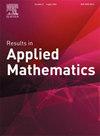Numerical modelling of advection diffusion equation using Chebyshev spectral collocation method and Laplace transform
Abstract
In this article a numerical method for numerical modelling of advection diffusion equation is developed. The proposed method is based on Laplace transform (LT) and Chebyshev spectral collocation method (CSCM). The LT is used for time-discretization and the CSCM is used for discretization of spatial derivatives. The LT is used to transform the time variable and avoid the finite difference time stepping method. In time stepping technique the accuracy is achieved for very small time step which results in a very high computational time. The spatial operators are discretized using CSCM to achieve high accuracy as compared to other methods. The method is composed of three primary stages: firstly the given problem is transformed into a corresponding inhomogeneous elliptic problem by using the LT; secondly the CSCM used to solve the transformed problem in LT domain; finally the solution obtained in LT domain is converted to time domain via numerical inverse LT. The inversion of LT is generally an ill-posed problem and due to this reason various numerical inversion methods have been developed. In this article we have utilized the contour integration method which is one of the most efficient methods. The most important feature of this approach is that it handles the time derivative with the Laplace transform rather than the finite difference time stepping approach, avoiding the untoward impact of time steps on stability and accuracy of the method. Five test problems are used to validate the efficiency and accuracy of the proposed numerical scheme.

 求助内容:
求助内容: 应助结果提醒方式:
应助结果提醒方式:


